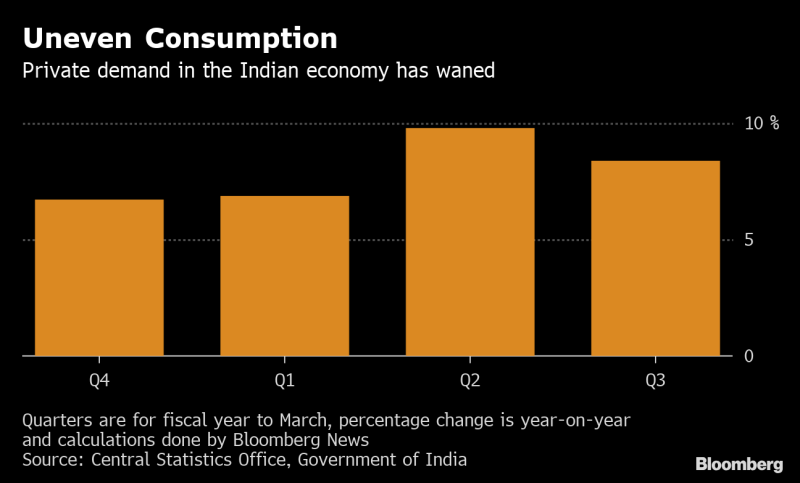

(Bloomberg) — Indian Prime Minister Narendra Modi’s biggest economic challenge as he starts his second term will be how to boost flagging growth to hold onto the crown of the world’s fastest-expanding major nation.
Gross domestic product data later Friday is expected to show the economy grew 6.3% in the first three months of the year, the fourth straight quarter of cooling. The annual expansion in the 12 months to March 2019 likely slowed to 6.9%, the lowest level in five years.
The economy has been on a steady slowdown since last year on the back of weaker consumption, waning global growth and an escalating U.S.-China trade war. Growth is now almost neck-to-neck with expansion in China, where authorities are already ramping up efforts to spur subdued activity. After securing a bigger election victory than in 2014, Modi is now under pressure to unveil measures to bolster growth.
“Arresting the slowdown and reviving the economy will be the first challenge for the new government,” said Sunil Sinha, principal economist at Fitch Ratings Ltd. in New Delhi. Reviving investments, easing a credit crunch among shadow banks and taking steps to cushion India from a global slowdown will be key, he said.
Budget Constraints
Fiscally, Modi has little room to stimulate the economy, having already pledged cash handouts of more than $10 billion to farmers from April this year. He is due to announce his cabinet later on Friday, including a finance minister to help implement economic policies.
The government has already deviated from its budget deficit goals, and with revenue collections trailing targets there’s a risk the shortfall for the fiscal year that ended in March could be higher than the estimated 3.4% of GDP. A miss will make India vulnerable to a credit-rating downgrade and push borrowing costs higher for local companies.
“Many of the policy choices to stimulate growth, like GST rate cuts, fiscal stimulus, monetary easing, also entail rising macro stability risks like inflation and current account deficit ahead,” UBS Group AG analysts, led by head of India research, Gautam Chhaochharia, wrote in a note.
The Reserve Bank of India may play its part to support the economy on June 6, with analysts betting on another interest rate cut to spur lending. Inflation remains well below the RBI’s 4% medium-term target, giving policy makers room to ease.
Prachi Mishra, chief economist at Goldman Sachs Group Inc. in Mumbai, expects one more rate cut — though not in June — and the RBI injecting more liquidity into the financial system.
“Going forward, we anticipate the banking system liquidity situation to normalize as currency in circulation reduces from its high post elections, and with potential liquidity operations by the RBI,” she said.
(Updates with cabinet announcement.)
–With assistance from Manish Modi.
To contact the reporter on this story: Anirban Nag in Mumbai at [email protected]
To contact the editors responsible for this story: Nasreen Seria at [email protected], Karthikeyan Sundaram
<p class="canvas-atom canvas-text Mb(1.0em) Mb(0)–sm Mt(0.8em)–sm" type="text" content="For more articles like this, please visit us at bloomberg.com” data-reactid=”37″>For more articles like this, please visit us at bloomberg.com
©2019 Bloomberg L.P.






